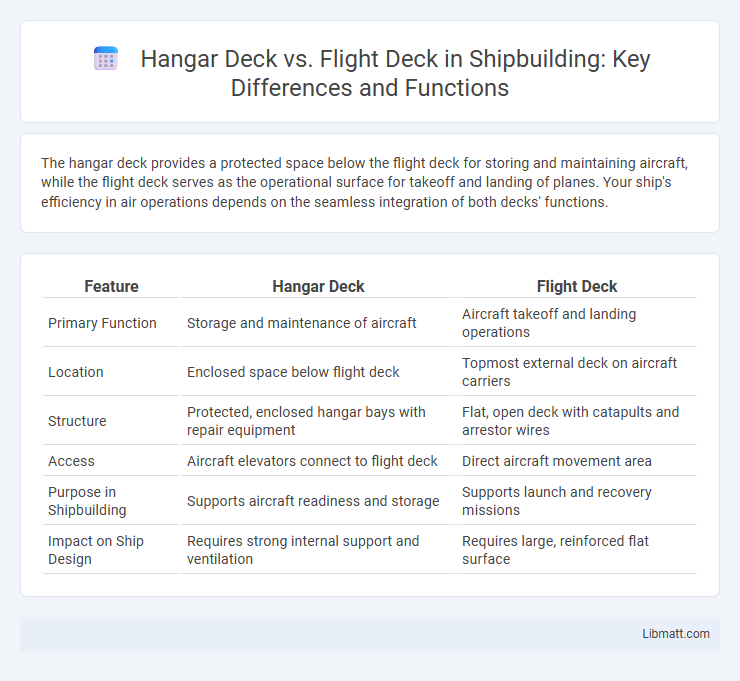The hangar deck provides a protected space below the flight deck for storing and maintaining aircraft, while the flight deck serves as the operational surface for takeoff and landing of planes. Your ship's efficiency in air operations depends on the seamless integration of both decks' functions.
Table of Comparison
| Feature | Hangar Deck | Flight Deck |
|---|---|---|
| Primary Function | Storage and maintenance of aircraft | Aircraft takeoff and landing operations |
| Location | Enclosed space below flight deck | Topmost external deck on aircraft carriers |
| Structure | Protected, enclosed hangar bays with repair equipment | Flat, open deck with catapults and arrestor wires |
| Access | Aircraft elevators connect to flight deck | Direct aircraft movement area |
| Purpose in Shipbuilding | Supports aircraft readiness and storage | Supports launch and recovery missions |
| Impact on Ship Design | Requires strong internal support and ventilation | Requires large, reinforced flat surface |
Introduction to Hangar Decks and Flight Decks
Hangar decks serve as the enclosed storage areas on aircraft carriers where aircraft are securely housed, maintained, and repaired away from the elements. Flight decks, in contrast, are the open, top-level platforms designed for launching and recovering aircraft, equipped with catapults and arresting gear to facilitate flight operations. Together, these decks are integral to an aircraft carrier's functionality, balancing aircraft maintenance with operational launch and recovery capabilities.
Definitions: What is a Hangar Deck?
A hangar deck is an enclosed area within an aircraft carrier designed for storing, maintaining, and repairing aircraft, protected from the elements and enemy attack. It provides vertical space below the flight deck, enabling the efficient organization and deployment of aircraft via elevators. Unlike the flight deck, which serves as the primary surface for launching and recovering aircraft, the hangar deck functions as the main storage and servicing hub.
Definitions: What is a Flight Deck?
A flight deck is the top surface of an aircraft carrier where aircraft take off and land, equipped with arrestor wires and catapults to facilitate these operations. It serves as the primary operational platform for launching, recovering, and handling naval aircraft. Unlike the hangar deck, which functions as an enclosed storage and maintenance area below, the flight deck is designed for active flight operations in open conditions.
Key Functions of the Hangar Deck
The hangar deck serves as a crucial storage and maintenance area for aircraft below the flight deck, providing shelter and space for repairs and inspections. Unlike the flight deck, which is primarily used for launching and recovering aircraft, the hangar deck ensures operational readiness by housing equipment, spare parts, and maintenance crews. Your understanding of carrier operations improves by recognizing that the hangar deck supports sustained air missions through efficient aircraft management and protection.
Key Functions of the Flight Deck
The flight deck serves as the primary operational area for launching, recovering, and directing aircraft on an aircraft carrier, making it crucial for air operations efficiency. Unlike the hangar deck, which is dedicated to storing and maintaining aircraft, the flight deck supports continuous takeoffs and landings, ensuring rapid deployment and turnaround of sorties. Your understanding of flight deck functions highlights its role in coordinating complex flight patterns and maintaining safety during intense carrier operations.
Structural Differences Between Hangar and Flight Decks
Hangar decks are enclosed spaces within an aircraft carrier designed to store and maintain aircraft, characterized by reinforced floors and internal support structures to bear heavy loads and accommodate maintenance equipment. Flight decks, by contrast, are open, flat surfaces with specialized materials like non-skid coatings and built-in arresting gear to withstand the impact of landing aircraft and facilitate takeoff operations. The structural design of flight decks emphasizes durability and resistance to extreme forces, while hangar decks prioritize spatial organization and protection from environmental elements.
Operational Procedures: Hangar Deck vs Flight Deck
Operational procedures on the hangar deck prioritize aircraft maintenance, storage, and preparation, ensuring that planes are efficiently serviced and ready for deployment. The flight deck focuses on launch and recovery operations, emphasizing timing, coordination, and safety to manage takeoffs and landings under dynamic conditions. Your understanding of the differing workflows is essential for seamless carrier aviation operations and mission success.
Safety Measures on Hangar Deck vs Flight Deck
Safety measures on the hangar deck prioritize fire prevention and containment due to the storage of aircraft and fuel, utilizing advanced fire suppression systems and strict no-smoking policies. In contrast, the flight deck emphasizes personnel protection against high-speed aircraft operations, including enforced safety zones, mandatory protective gear, and continuous communication protocols to manage takeoffs and landings. Both decks implement rigorous training and emergency drills to maintain operational safety under challenging naval conditions.
Roles in Aircraft Carrier Operations
The hangar deck serves as the primary storage and maintenance area for aircraft on an aircraft carrier, providing essential space for repairs, inspections, and equipment staging. The flight deck functions as the operational platform for launching and recovering aircraft, equipped with catapults, arrestor wires, and landing aids to ensure rapid and safe flight operations. Together, these decks coordinate to maintain continuous air operations, maximizing the carrier's sortie generation rate and combat readiness.
Conclusion: Hangar Deck vs Flight Deck Comparison
The hangar deck serves as the primary storage and maintenance area for aircraft below the flight deck on an aircraft carrier, providing protection and repair facilities. In contrast, the flight deck is the exposed, top surface designed for launching and recovering aircraft, equipped with catapults and arresting gear. Overall, the hangar deck supports operational readiness through storage and servicing, while the flight deck enables active flight operations and rapid deployment.
Hangar deck vs flight deck Infographic

 libmatt.com
libmatt.com